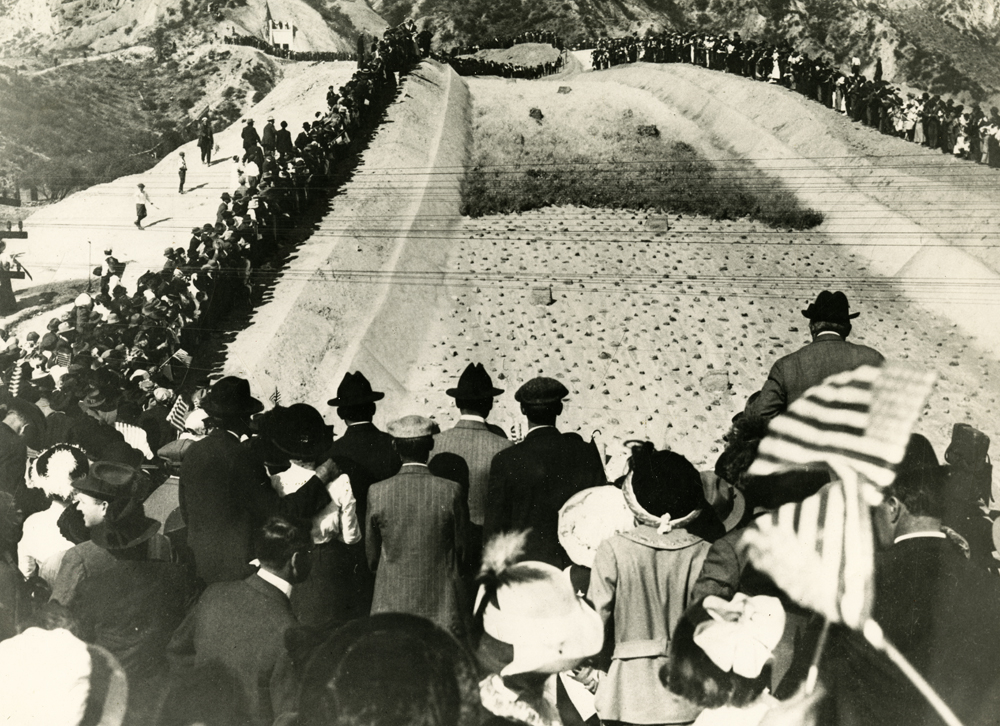A century’s supply: UCLA Library celebrates history of LA Aqueduct

The L.A. Department of Water and Power constructed the L.A. Aqueduct a century ago to bring water from Owens Valley to the growing City of Angels. Many have said the aqueduct was instrumental in allowing Los Angeles to grow to the large city it is today.
The original version of this article contained multiple errors and has been changed. See the bottom of the article for additional information.
UCLA graduate and doctoral students are compiling poetry, art and research projects to take part in today’s centennial celebrations of Los Angeles’ transformative 233-mile aqueduct.
The students’ ventures are based on information from a UCLA Library project called the Los Angeles Aqueduct Digital Platform, which digitized archives about the L.A. Aqueduct.
“We’re really concerned about providing access and preserving the history of both sides,” said Jasmine Jones, manager of the project for the UCLA Library Special Collections.
The UCLA Library project launched earlier this year, after L.A.-based filmmaker Lauren Bon realized that it was hard to find complete information about the aqueduct. She approached Jillian Cuellar, the head of the Center for Primary Research and Training at UCLA, with a proposal for a digitization project of sources surrounding the L.A. Aqueduct.
“Part of our mission is to provide historical record and access. Both are equally important,” Cuellar said.
The aqueduct was completed in 1913 by the Los Angeles Department of Water and Power to meet the city’s need for a more consistent source of water following Los Angeles’s rapid population boom in the early 1900s.
Prior to the aqueduct’s completion, L.A.’s main source of water was the Los Angeles River. But officials found the river was not enough to support the growing population.The aqueduct originally consisted of three large storage reservoirs and 233 miles of waterways, which use gravity to transport water to the city from Owens Valley, according to the Los Angeles Department of Water and Power website.
“The L.A. Aqueduct is one of the greatest engineering projects of the 20th century and is the reason for L.A. being the city it is today,” said Michelle Vargas, senior public relations specialist at the Los Angeles Department of Water and Power.
The centennial of the city’s landmark, however, does not come with unanimous celebration. Some of the citizens of Owens Valley felt angry and betrayed that the city of Los Angeles received the water that they needed, according to the the department’s website. Today, the lake is mostly dry because water was diverted to L.A.
“The centennial is an opportunity for the people of Los Angeles to reflect on how we used water in the past,” said Jon Christensen, adjunct assistant professor at UCLA’s Institute of the Environment and Sustainability and the department of history.
For Christensen, there are ways for Los Angeles to rely less on the aqueduct as a source for water, such as recycling rain water from the San Fernando Valley channels.
English graduate student Christian Reed participated in the UCLA library project with a piece focusing on the use of the sonnet to think about the relationship between L.A. and the source of its water in the High Sierras. Through the collection of poems, each individually composed by members of the UCLA and L.A. community, Reed plans to provide a multilayered story of the L.A. aqueduct.
“It’s been an interesting thing for me to see how the written word and the natural world can interact and can find in one another new resources and new ways of being what they are,” Reed said.
Computer science graduate student Manjana Chandrasekharan, another student contributor, said she was not aware of L.A.’s water source prior to working on the project.
“The story was so full of potential to explore,” Chandrasekharan said.
For her project, Chandrasekharan will create a digital mosaic using photos from the archives. The photos will open up individually and provide narratives that Chandrasekharan will have inferred using her research, she said.
Multiple students worked on the UCLA Library’s L.A. Aqueduct Digital Platform this summer, including cinema and media studies graduate student Matthias Stork.
Stork’s research project focused on the mythologizing of the aqueduct’s history through films such as “Chinatown,” which outlines disputes between the Owens Valley and the Department of Water and Power.
“It offered an interesting perspective on the Los Angeles Aqueduct, combining cinema with Los Angeles history,” Stork said.
Stork, as well as the other graduate students who worked on the project, mentioned how the archival material allowed them to understand better the impact of water sources for a city such as Los Angeles.
“The Los Angeles Aqueduct is the reason why Los Angeles is what it is today,” said Stork.
Correction: The UCLA Library project launched after L.A.-based filmmaker Lauren Bon realized that it was hard to find complete information about the aqueduct. The photo accompanying this article belongs to UCLA Library Special Collections.


